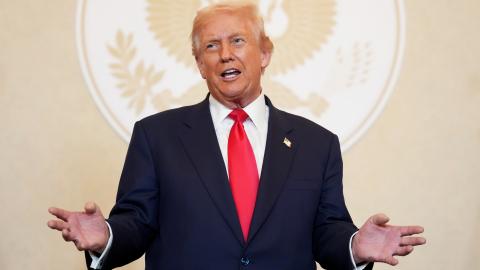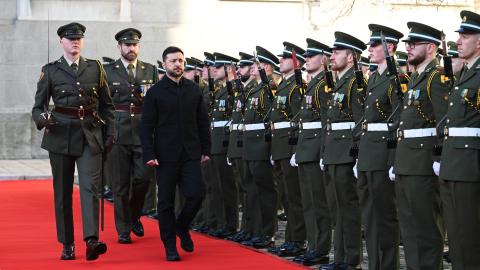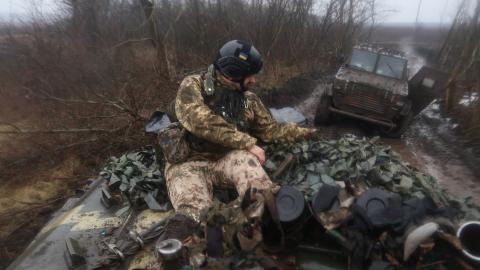This report first appeared as a part of Hudson's Re: Ukraine newsletter series. To subscribe, click here.
Below Hudson Senior Fellow Can Kasapoğlu offers a military situational report about the war in Ukraine.
1. Iran and Russia Strengthen Ties from the Caspian to Bryansk
One of the most dangerous consequences of the Russian invasion of Ukraine has been the emergence of Iran as a threat to NATO’s eastern flank. Developments of the past week suggest that Russia and Iran are only strengthening their bilateral relationship.
First, Iran’s fingerprints are all over Russian combat operations. The British Ministry of Defense reported that the Russian military has started launching Iran-manufactured loitering munitions salvos from Bryansk. This suggests that Iran has been developing its disruptive military capabilities in a broader theater. Russian launch sites for Shahed-136 and Shahed-131 loitering munitions operations previously had been located across the Sea of Azov in Krasnodar. Besides, Tehran is now actively participating in infrastructure projects on the Volga River too.
Second, Central Intelligence Agency Director William Burns stated this week that Russia has been proposing to help the Iranians with their missile program in return for Tehran’s military assistance in Ukraine, echoing Hudson Institute analysis addressing what Iran receives in return for its favors.
Iran has already secured a lucrative deal for the Su-35 air-superiority fighters, boosting its airspace control. Tehran’s wish list could potentially include ramjet engines for sea-skimming supersonic anti-ship missiles, RD-250 aerial engines for empowering intercontinental ballistic missiles (mimicking the North Korean example), and land-attack cruise missile technologies enabling an effective range of more than 2,000 kilometers (1,240 miles).
The February 15 edition of this report drew attention to Iran’s drone plant project in Russia, concluding that joint production of loitering munitions there might merely be the tip of the iceberg. The involvement in this project of the Revolutionary Guards’ famed military scientist, Brigadier General Abdollah Mehrabi, suggested as much. In light of Director Burns’ assessments, it is likely that the plant might also facilitate advanced military cooperation on missile technologies.
2. The Fight for Bakhmut Continues
This week President Volodymyr Zelensky affirmed Kyiv’s resolve to defend Bakhmut, notwithstanding Ukraine’s mounting casualties and Russian units’ steady advances there.
President Zelensky boldly announced that he has ordered additional reinforcements to defend the town. Open-source conflict monitoring also suggests that Ukrainian Chief of Staff General Valery Zaluzhny as well as Chief of the Army General Oleksandr Syrskyi back this decision.
While political considerations dictate a strong defense of the beleaguered city, from a military perspective, the loss of Bakhmut would not prove catastrophic. In fact, the Secretary of Defense Lloyd Austin stated that a Ukrainian withdrawal from Bakhmut would not mark a significant setback, since the town was of mainly symbolic value. Some experts considered Secretary Austin’s comments a suggestion for tactical withdrawal.
Kyiv’s decision to hold the line in Bakhmut at all costs evokes the steely resolve of the Spartans at the Battle of Thermopylae, dramatized memorably in the cult classic film 300. In that battle, however, Spartan King Leonidas’ military strategy required maintaining a topographically favorable defensive position with minimum force requirements against all odds while inflicting maximum casualties on the adversary, the invading Persian war party.
Sadly, resolve may be the only characteristic shared by the Spartans and the Ukrainians, as the battle for Bakhmut does not favor the defenders in terms of battleground geometry or force generation requirements. Russian forces currently threaten the Ukrainians’ lines of communication. At present, Wagner units, supported by Russian airborne troops (VDV), have penetrated the town’s tactical depth, while flanking the supply routes of the Ukrainian Armed Forces. More importantly, the situation demands continuous reinforcements that stretch Kyiv’s limited manpower. Evidence suggests that elite Ukrainian units, such as the 93rd Mechanized Brigade and the 5th Assault Regiment, are fighting in the vicinity of Bakhmut.
The battle threatens to further attrite Ukrainian forces and increase their casualties. This outcome, regardless of who holds Bakhmut when the music stops, can potentially jeopardize Ukraine’s long-awaited counteroffensive campaign.
3. Chechen Intrigue Plays Out in Ukraine
Chechen strongman Ramzan Kadyrov may have severe kidney problems. According to recent stories, Kadyrov has been receiving serious nephrology treatment from a foreign medical team, and his situation could be life-threatening. Indeed, recent pictures of Kadyrov showcase a bloated, swollen face, leading to suggestions that he may have been poisoned or indeed may be suffering from systemic health troubles. When his young son Akhmat recently went in his stead for a brief meeting with Vladimir Putin, the rumors about Ramzan flared up even more.
Kadyrov’s health problems highlight how the war has the potential to ignite another regional conflict long held to a slow boil: a Chechen civil war. Along with the fate of the Russian siloviki leadership, namely the Soviet-remnant intelligence elite, the outcome of the intra-Chechen conflict playing out in Ukraine will determine the post-war status quo in the North Caucasus.
This civil war is being fought by pro- and anti-Russia camps. On the pro-Russia side, Kadyrov’s units have been actively taking part in combat operations. These hardened fighters have fought in critical episodes of the conflict, like the Battle of Mariupol. Some intelligence even suggested that Chechen hit squads were hunting President Zelensky in the opening moves of the war.
Against Kadyrov’s pro-Kremlin fighters, several anti-Russia Chechen battalions are fighting alongside Ukrainian forces. These Chechen combat formations have been growing closer for some time. Notably, Akhmad Zakayev, a veteran of the Russo-Chechen wars of the 1990s and the head of the Chechen government-in-exile, has been pioneering efforts to gather seasoned Chechen fighters in Ukraine.
This anti-Putin Chechen presence in the war is winning the approval of Ukrainian lawmakers. In late 2022, the Ukrainian Parliament (Verkhovna Rada) passed a resolution recognizing the Chechen Republic of Ichkeria as “temporarily occupied” by Russia.
These machinations highlight how the ongoing war is not merely about Ukraine, but about the fallout from the dissolution of the Soviet Union some 30 years ago. The status quo in Chechnya depends upon Kadyrov’s iron-fist rule supported by Putin’s backing. A decisive Russian defeat in Ukraine could open Pandora’s box in the North Caucasus, precipitating what a previous Hudson Institute publication rightly named “the final collapse of the Soviet Union.”
4. Smart Wings in Action: JDAM-ERs for the Ukrainian Air Force
According to reporting this week, the United States’ recent $1.85 billion military assistance package includes Boeing-manufactured JDAM-ER aerial high-precision munitions.
Joint Direct Attack Munitions (JDAMs) enjoy guidance packages consisting of GPS and INS (internal navigation system). The guidance package transforms otherwise dumb aerial bombs into very accurate “fire and forget” weapons. The ER (extended range) variant offers all the aforementioned advantages, but with better range due to the winged design of the aerial bomb kit. Boeing reports that the wing variant triples the gliding range of the original JDAMs, making the weapon effective beyond 40 miles.
The “fire and forget” characteristics are of critical importance to the Ukrainian Air Force, which flies brief sorties to evade detection. While it would be dangerous for the Ukrainian Air Force to employ the JDAM-ER from mid-altitudes due to threats from Russian fighter aircraft and air-defense systems, Ukrainian pilots could opt for toss-bombing—pulling up immediately prior to releasing their weapons to unleash the JDAM from an upward trajectory. This, as military writings for JDAM operations in contested environments suggest, would compensate for the loss of maximum effective range from low-altitude release. In practice, the JDAM-ER would allow the Ukrainian air deterrent to target the Russian rear using a reliable weapon with a per-unit cost less than that of high-end missiles.
Along with the AGM-88 anti-radiation missiles Ukraine received last year, the Boeing JDAM-ER marks one of the most important efforts to arm Ukraine’s Soviet-Russian aircraft with Western aerial weapons that are up to NATO standards. It remains to be seen which aircraft types (Mig-29, Su-24, or Su-27) would be given the privilege of flying with these high-precision bombs.


















